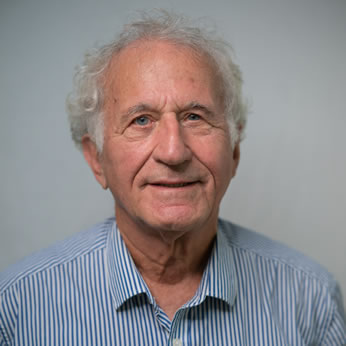Post doc: University of Wisconsin, Madison, USA
Ph.D: Technion, 1977
Awards
- 2010 Medal of CMOA (Centre de Mecanique Ondulatiore Appliquee founded by Louis de Broglie) “as a recognition of his contributions to the development of the non-hermitian quantum mechanic”.
- 2009 J. Phys. B: Atomic, Molecular and Optical Physics, dedicated a special issue (# 4, Vol. 42) on resonances to the applicant on accounts of his “research with important contributions”.
- 2006 The Landau Prize for Sciences and Research in physical chemistry for “enormous contribution to the promotion of the research into non-Hermitian quantum mechanics, and for the developement of the theory of resonance states.”
- 2006 The Israel Chemistry Society Prize for Excellence, “for the origional and insightful contributions to theoretical chemistry, to resonance theory and its applications to phenomena in molecules”.
- 2002 The Kaplan Prize in Creative Management for 21st Century High Technology (together with Dr. Ilya Vorobeichik and Professor Meir Orenstein).
- 1999 Herschel Rich Technion Innovation Award.
- 1998 The Henry Taub Prize for Excellence in Research.
- 1996 Alexander von Humboldt – Lise Meitner Senior Research Award (Germany).
- 1995 Recipient of the Bertha Hartz Axel Chair of Chemistry.
- 1994 “Award of Four Months of Visiting Professorship in Europe”, Marie Curie Fellowship – Directorate General for Science Research and Development, Commission of the European Communities. 1994 “Yakov Sapir Award”, Israel Ministry of Science.
- 1991 “The Henry Gutwirth Award for the Promotion of Research”.
- 1989 “New England Award for Academic Excellence”, Technion.
- 1981 – 1983 “Yigal Allon Fellow, award for Young Outstanding Scientists in Universities in Israel”.
- 1978 A member of the Honor Scientific Organization of North America – Sigma xi (elected by the University of Wisconsin, Chapter of the Society).
- 1977 – 1978 Yad-Avi-Hayeshuv Fellow, given to Ph.D. student for studying overseas by the Hebrew Technical Institute (US-Israel Educational Foundation).
- 1975 Recipient of Landau Research Prize – award for outstanding graduate students.
In the past, this group has worked on formulation of non-Hermitian quantum mechanics (NH-QM) and derived the complex variational principle, complex perturbation theory, the complex product (c-product), bounds to the complex resonance energies. The impact of series of papers was and still is very large.
The theory we derived has been used by us as a mean to study decay rates in unimolecular reactions, study of the structure of metallic surfaces by helium diffraction, study of the resonance positions and widths in van der Waals complexes and in pre-desorption reactions, the calculation of thermal rate constants, study the electronic correlation effect in high harmonic generation and calculation of the above threshold ionization spectra. We have used the NHQM formalism we derived to carry out the first ab-initio numerically exact study of the probability to form protonium by a collision of antiproton with hydrogen atom (according to the Editor of J.Phys.B our paper had the largest downloads they have ever had in the first month after publication) and our NHQM theory is used extensively in the study of elementary particles reactions (e.q. by the center of the Asian nuclear reaction database in Japan directed by Prof. Kiyoshi Kato).
In 2008 we discovered that light-induces conical intersections (LI-CI) even for diatomic molecules for which CI does not exist in nature. In view that CIs play a key role in many photoinduced chemical reactions such as in photosynthesys and in the mechanism of vision we believe that our that was done together with a post-doctoral fellow from Haifa, Milan Sindelka and Lorenz S. Cederbaum from Heidelberg has a special interest.
Our series of studies of the resonance phenomena in wave guides lead to the invention of a stable optical switch which has been developed to a commercial product for optical communication by a startup company OpTun the applicant founded with his student Ilya Vorobeichik and Prof. Meir Orenstein (this company merged recently with the American company NeoPhotonics). Our work based on our NH-QM theory published in PRL (2009) together with Dr. Uwe Gunter from Germany gave one of the first illustration of PT symmetry in physical system (coupled waveguides) and has opened a new field of research.
The term self-orthogonality was given by us and we were the first to show its relevance to the calculation of auto-ionization resonances. In 2008 together with our guest Prof. Roland Lefebvre from France we gave the first illustration of the self-orthogonality effect on the photoinduced dynamics of a molecule in a strong chirped laser field. Most recently together with a PhD student Raam Uzdin from our group and we have discovered the breakdown of the adiabatic approach in time evolution of an initial state in the vicinity of an exceptional point in the spectrum of the non-hermitian hamiltonian. This discovery changed the notion that at all circumstances the slower the potential parameters are varied in time, the more negligible non-adiabatic couplings become (an approach which is a milestone in the calculations of Berry phases in different types of chemical and physical systems).


